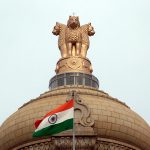TOPIC: Conservation, environmental pollution and degradation, environmental impact assessment
How does the Kyoto Protocol work?
- Under the protocol, each Annex- B country is given emission targets in the form of ‘quota’ or Kyoto Units.
- For example, for the year 2009, Australia’s allowed quota was 2,957,579,143 Kyoto Units where each unit is equivalent to 1 ton of Carbon Dioxide. This means that Australia can emit this much of GHGs.
- The Australian government will first have to make sure that it does not cross this quota limit.
- So to achieve this, it can make compulsory anti-pollution laws.
- It can promote solar energy by reducing taxes on solar cells.
- It can tax automobiles like higher taxes on buying another car.
- But even after taking these measures, if Australia wants to emit more GHGs, then it will have to buy additional quota or Kyoto Units from another country.
- The protocol allows three mechanism to do so. These are: Carbon Trading, Clean Development Mechanism and Joint Implementation.
- Carbon Trading: Carbon credits create a market for reducing GHGE by giving a monetary value to the cost of polluting the air. Emissions become an internal cost of doing business and are visible on the balance sheet.
- Example 1: Consider a business that owns a factory emitting 100,000 tonnes of GHG in a year. It is located in an Annex 1 country which enacts a law to limit the emissions that the business can make. so, the factory is given a quota of say 80,000 tonnes per year. The factory will either reduce its emissions to 80,000 tonnes or will be required to purchase carbon credits to offset the excess. If it feels that it is not feasible to reduce emissions it may choose to buy carbon credits in the open market from organizations that have been approved to sell carbon credits.
- Example 2: Suppose Japan and Australia are two annex B parties. Japan has a quota of 100 units while it emits only 90 units. And Australia has a quota of 200 units but it emits 210 units. So Australia can buy these 10 spare Kyoto Units from Japan and thereby remain within its limits.
2. Clean Development Mechanism (CDM) : Suppose Annex B country Australia is given a quota of 200 units, but it emits 210 units of GHGE. And it finances a solar power project in a Non-Annex or a developing country and gets a certificate that the solar plant led to a reduction of 10 units of GHG. In this way, Australia will remain within its quota limits.
3. Joint Implementation (JI) : This is similar to the CDM. Here, Australia can do the good project in another Annex-B country to meet the quota.
Why did USA not ratify the Kyoto Protocol?
USA refused to ratify the protocol because of apprehensions that it would damage its economy. For example, a US company would either have to buy carbon credits or invest in some project in developing countries. This will increase their cost of production. While on the other hand countries like India or China have no such obligations so their cost of production will be low. This will make their products cheaper and will divert the US customers towards them.
So USA feels that the treaty is flawed because it does not impose any obligations on developing countries to cut their emissions.
Why Canada withdrew from the protocol?
Canada was the first country to quit the Kyoto Protocol. It did so because according to it the 1997 accord was handicapped as the top GHG emitters like USA (refused to ratify) and China (not binding )were not covered by it.
Penalties
- A country loses privilege of gaining credits through IT projects.
- If the country crosses its quota limit and does not try to make up for the difference, then it must make up for the difference plus an additional 30 percent during the next period.
- The country could be banned from ‘cap and trade’ program.
Commitment Period of Kyoto Protocol
- Its first commitment period was from 2008 to 2012. So there were two options available
- First- to extend the commitments under the Kyoto Protocol until 2020
- Second- to create a successor of Kyoto Protocol i.e. a post-2012 international climate treaty.
Highlights of Doha CoP-18 ( held in 2012)
It resulted in three decisions together called as “Doha Climate Gateway”.
-
Second Commitment Period
(Pre-2020)-
- The protocol has been extended with a second commitment period of 8 years starting on 1st January, 2013 and ending on 31st December, 2020.
- Annex 1 parties that have agreed to the second commitment period obligations will have to review their emission targets during 2014.
- The host country for the Green Climate Fund (GCF) was approved to be South Korea.
- Replace the list of GHGs in Annex A with a new list that adds Nitrogen Trifluoride to a revised basket of seven GHGs.
- The left over units from the first commitment period will not be carried over to the next period. They will instead be transferred to a “separate account” which would significantly reduce their value. It was a controversial decision and it was also decided that surplus units of first period could be sold and purchased in the second period also but only on the condition that the selling party must be in the second period.
GCF is a fund within the framework of the UNFCCC. It was founded as a mechanism to transfer money from the developed to the developing world, in order to assist the developing countries in mitigation and adaptation practices to counter climate change.
GCF is used for NAMA (Nationally Appropriate Mitigation Action) under Bali Action Plan for mitigation by developing countries.
GCF was launched in 2010 during CoP 16 in Cancun, Mexico.
2. Headway on Bali Action Plan
- India’s principle of equity i.e. CBDR was reintroduced in the negotiation after it had been kept out of the talks in 2009 & 2010. It was also supported by G-77 and China.
- India also argued that NAMA is voluntary reductions by developing countries in accordance with their respective capabilities and should be supported and enabled by technology transfer from developed countries. By definition, NAMA will vary by country.
- India also ensured that agriculture, being a sensitive sector of our economy, was kept out of the mitigation programme.
* NAMA was first used in the Bali Action Plan ( CoP-13, 2007) and was subsequently forwarded to the Copenhagen Accord. It applies to the developing countries.
** National Adaptation Programme of Action (NAPA) are action plans submitted by the Least Developed Countries (LDC) on how to adapt to climate change.
Criticism: Some have criticized NAMA as encouraging enormous subsidy programmes funded by developed countries and implemented on a voluntary basis by developing countries.
3. Successor of Kyoto Protocol and Debate on Principle of Equity (Post 2020)
- A successor of Kyoto Protocol is to be developed by 2015 and implemented by 2020 but there is a debate on its nature.
- The rich countries argue for a universal treaty with all nations of the world as parties and binding targets for all. The poor and developing countries on the other hand insist that the developed nations have a historical responsibility of creating the problem of global warming and climate change. Hence, they must take a larger responsibility of emission reduction. This is called ‘Principle of equity’.
Russia, New Zealand, Japan and Canada left the Second Commitment Period of Kyoto Protocol.
Highlights of Warsaw CoP-19 (held in 2013)
- Methane reductions : Although methane reductions have been highlighted in the IPCC report, agriculture has been again kept out of mitigation.
- New Carbon Marketing Mechanism: The developed countries have started pushing for a piecemeal approach to the global deal. Earlier, they wanted a global climate treaty with GHG reduction targets i.e. mitigation being decided first in 2015 and decisions on adaptation, technology and finance being segregated and postponed for later years. Now they are promoting the idea that the talks must deliver a New Carbon Marketing Mechanism even before mitigation.
Developing block has opposed to sign such a piecemeal global climate treaty and has put in a submission to the UNFCCC, advocating that all elements of the deal- mitigation, adaptation, technology and finance should be addressed at the same time as part of a balanced package.
3. Loss and damage: The G-77 and China have proposed this and wants the developed world to abide by it. The phrase ‘Loss and damage’ refers to the entire range of damage and permanent loss ‘associated with climate change in developing countries’ that can no longer be prevented through mitigation or adaptation. There are limits to adaptation and risk reduction. Both economic and non-economic losses will have to be considered.
Economic losses include structural damage from floods, hurricanes or crop loss due to drought or extreme heat.
Non-economic losses include cultural loss, loss of livelihoods and loss of integrity.
India can play an important role as a mediator in this impasse.
Highlights of Lima CoP-20 (held in 2014)
- All nations will be asked to submit plans for curbing GHGE , known as “Intended Nationally Determined Contributions” or “INDCs” to the UN by an informal deadline of March 31, 2015 as the core of a Paris deal.
- The conference also invited actions by all nations to combat warming, removing a distinction in a 1992 climate convention that split the world into two camps of rich and poor under which the rich had to lead the way.
- Many emerging economies insisted on the continuation of the split. but the US and other rich nations insisted that the world had changed and the developing countries also had to curb their rising emissions.
- The diplomatic formula encompassing the rival demands ended up in the text as ” Common But Differentiated Responsibilities and respective capabilities in light of different national circumstances”.
- The conference reiterated a goal for developed nations to mobilize $100 billion a year, in public and private funds, in climate aid for developing nations by 2020.
- The talks agreed on a document of ‘elements’ that will form the basis of a negotiating text for Paris in 2015.
- Developing countries vulnerable to extreme weather successfully won a mention of “Loss and Damage”.
Highlights of Paris CoP-21 (held in 2015)
- A global agreement on the reduction of GHGE was negotiated and it was agreed to limit global temperatures to 2 º C above pre-industrial levels and to strive to further reduce the limit to 1.5 º C.
- It was agreed that each country will submit their GHGE reduction plans every five years whose reporting and monitoring will be transparent and comprehensive. But the targets were not specified and it was left to the countries to set a nationally determined contribution. The implementation and compliance of the targets are not legally binding. This renders the entire process ineffective.
- The agreement will be legally binding only if it is joined by atleast 55 countries contributing atleast 55 percent of global GHGE.
- The developed countries were asked to raise atleast $100 billion annually to assist developing countries in reducing their GHGE. Developed countries succeeded in inserting a provision asking developing countries to also raise financial resources, even as a voluntary effort.
- A committee of experts to ‘facilitate implementation’ and ‘promote compliance’ has been mooted but there is no agreement to empower it to punish violators.
- Many countries have argued that they cannot jeopardize their developmental needs by drastic cuts in GHGE. No consensus has evolved over this issue.
- Another issue was whether any compensation would be given to countries who have done nothing but will still face irreparable damage due to climate change. There was no consensus on this issue as well.
- India and France together launched an International Solar Alliance to boost solar energy in developing countries.The alliance includes around 120 countries that support the “Declaration on the occasion to launch the international solar alliance of countries dedicated to the promotion of solar energy”. It was noted that developing countries need technology and capacity building to quickly take solar energy to scale, and that initial public financing is important for solar energy to take hold in developing countries.
Read More: UN Framework Convention on Climate Change











